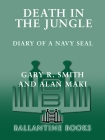Death in the Jungle Gary Smith (mobi reader txt) 📖

- Author: Gary Smith
Book online «Death in the Jungle Gary Smith (mobi reader txt) 📖». Author Gary Smith
Automatic weapons man (AW man): Usually carried an M-60 or Stoner machine gun. There were usually at least two AW men per SEAL platoon, and were placed toward the middle of the patrol for tactical mobility. His main responsibility was to neutralize or suppress heavy pockets of enemy fire.
Azimuth: The azimuth of an object is its bearing from the observer, measured as an angle clockwise from true North.
Back water: Command given to oarsmen to reverse usual rowing motion.
Bitter end: The free end of a line, wire, or chain.
Boston Whaler: Eighteen feet in length and powered by assorted outboard motors. In 1967/68 the Chrysler 105-horsepower outboard engine was used. Its draft was two feet. It carried one SEAL squad of seven men and two Boat Support Unit crewmen. Using the power propeller, the Boston Whaler could speed along at about 35 knots, fully loaded. It was great for insertions and extractions, and was occasionally called upon for fire support.
Bulkhead: One of the vertical, wall-like structures enclosing a compartment.
Bunker: A protective structure made of mud, sticks, and logs. Easily made and repaired, a bunker was like a beaver dam in its ability to resist destruction. Small home bunkers were made to hold all family members, and sometimes had a tunnel leading to an escape route. The larger bunkers built in VC/NVA camps could house ten to fifteen men.
Chain of command: Succession of commanding officers through which command is exercised from superior to subordinate. Also called command channel.
Command: A term applied to a naval unit or group of units under one officer; a definite and direct form of an order.
Commanding Officer (CO): The “Old Man” of the command. In a SEAL Team, he was delegated the responsibility and authority to accomplish all tasks assigned to him and his command by NOSG (Naval Operations Support Group), which later became NSWG (Naval Special Warfare Group). During the Vietnam War, the CO was a lieutenant commander (O-4) in rank. After the war, the rank was changed to commander (O-5).
Compartment: Space enclosed by bulkheads, deck, and overhead; corresponds to a room in a building.
Compass: Instrument to indicate geographic directions.
Compass man: Usually the patrol leader, and follows the point man. The point man guides on his direction.
Coxswain: Enlisted man in charge of a boat, usually acts as helmsman.
CPO: Chief petty officer (E-7).
C rations: Individual meals for use in the field when a field mess was not available. They were balanced and sufficient. The only ingredient that was much needed and not furnished with the meals was Tabasco sauce. If the flavor of the meal was not quite up to snuff—just add some Tabasco sauce! One disadvantage was weight. SEAL platoons generally had to carry all of their food and water. “LRRP rats” (LRRPs) were light; however, because they were dehydrated they required the better part of a quart of water for each meal. Unfortunately, LRRPs required a lot of Tabasco sauce. Take your choice.
Crossing the line: Crossing the earth’s equator.
Crossed over the bar: When a seaman had passed from this life to the next one.
Danger area: An area (i.e., river, road, hootch, base camp, mined area, etc.) that decreases the patrol’s cover and concealment, security, and firepower because of terrain features, man-made obstacles, enemy forces, et cetera. SEAL patrols established SOPs for danger areas that maximized cover and concealment, security, and firepower.
Davy Jones’ locker: The bottom of the sea.
Dead ahead: Directly ahead of the ship’s bow; bearing 000 degrees relative.
Deck: On a ship, corresponds to the floor of a building on land.
Decontaminate: Act of removing residue of nuclear or chemical attack. Also included removing leeches and, especially, black ants that plagued the Rung Sat.
Deep: The distance in fathoms between two successive marks on a lead line, as “By the deep, four.”
Deeps: In a lead line, the fathoms which are not marked on the line.
Deep six: A term meaning to dispose of by throwing over the side of a ship.
Dexamil: A stimulant in capsule form that was issued to SEALs to be used as a “stay-awake” pill while on ambush site. The platoon corpsman issued one per man per night.
Dinghy: Small, handy boat, sixteen to twenty feet in length, propelled either by oars or by sail.
Ditty bag, ditty box: Small container used by sailors for stowage of personal articles or toilet articles.
Dock: Artificial basin for ships, fitted with gates to keep in or shut out water; water area between piers.
Door: Opening between compartments; see hatch.
Dory: Small, flat-bottomed pulling boat, used chiefly by fishermen.
Douche kit: Another name for ditty bag.
Ebb tide: Tide falling or flowing out.
Eddy: A small whirlpool, especially in river streams.
Even keel: Floating level; no list.
Executive Officer (XO): Subordinate to the CO. He is responsible for carrying out the policies of the CO. During the Vietnam War, the rank of a Team XO was lieutenant (O-3). After the war, the required rank was changed to lieutenant commander (O-4).
Extra duty: Additional work assigned as mild punishment.
Fag: Frayed or untwisted end of rope.
Fair wind: A favoring wind.
Fantail: Main deck section in the after part of a flush-deck ship.
Fathom: A six-foot unit of length.
Feather: Turning the blade of an oar horizontally at the finish of a stroke to reduce resistance of air or water; changing the pitch of a variable-pitch propeller on an airplane to vary amount of bite into the air.
Field-strip: To disassemble, without further breakdown, the major groups of a piece of ordnance for routine or operating cleaning and oiling; as opposed to detailed stripping, which may be done only by authorized technicians.
Fire superiority: Gained by directing an accurate and heavy





Comments (0)